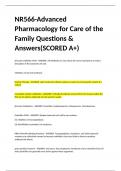NR566-Advanced
Pharmacology for Care of the
Family Questions &
Answers(SCORED A+)
β-lactam antibiotic MOA - ANSWER All antibiotics in class share the same mechanism of action:
disruption of the bacterial cell wall.
Inhibition of cell wall synthesis
Empiric Therapy - ANSWER start treatment without cultures or prior to receiving the results of a
culture
immediate empiric antibiotics - ANSWER Critically ill patients receive (Fill in the Answer) after the
first set of cultures obtained; do not wait for results.
β-lactam Antibiotics - ANSWER Penicillins, Cephalosporins, Carbapenems, Monobactams
Penicillins MOA - ANSWER Weaken bacterial cell wall by two actions:
(1) inhibition of transpeptidases
(2) disinhibition (activation) of autolysins.
PBPs (Penicillin Binding Proteins) - ANSWER Transpeptidases, Autolysins, and other bacterial
enzymes are collectively named as because antibiotic class must bind to them to produce
antibacterial effects.
gram-positive bacteria - ANSWER two layers: the cytoplasmic membrane and a relatively thick cell
wall; penicillins are generally very active against these organisms.
,gram-negative bacteria - ANSWER three layers: the cytoplasmic membrane, a relatively thin cell wall,
and an additional outer membrane; only certain penicillins (e.g., ampicillin) are able to cross and
reach penicillin binding proteins (PBPs)
Four Major Groups of Penicillins - ANSWER (1) narrow-spectrum penicillins that are penicillinase
sensitive
(2) narrow-spectrum penicillins that are penicillinase resistant (antistaphylococcal penicillins)
(3) broad-spectrum penicillins (aminopenicillins)
(4) extended-spectrum penicillins (antipseudomonal penicillins).
narrow-spectrum penicillins: Penicillinase sensitive penicillins - ANSWER Penicillin G, Penicillin V
narrow-spectrum penicillinase sensitive susceptible pathogens - ANSWER Streptococci, Neisseria,
anaerobes
Bactericidal antibiotics - ANSWER Directly kill bacteria: Agents include aminoglycosides, beta-
lactams, fluoroquinolones, metronidazole, most antimycobacterial agents, streptogramins, and
vancomycin.
preferred for immunocompromised patients such as those with diabetes, HIV, or cancer and for
those who have overwhelming infections
Bacteriostatic agents - ANSWER inhibit bacterial proliferation while the host's immune system does
the killing. Agents include clindamycin, macrolides, sulfonamides, and tetracyclines
very narrow antimicrobial spectrum and are used only against penicillinase-producing strains of
staphylococci (S. aureus and S. epidermidis). - ANSWER narrow-spectrum penicillins: penicillinase
resistant penicillins
,narrow-spectrum penicillins: penicillinase resistant penicillins - ANSWER Nafcillin, Oxacillin,
Dicloxacillin
narrow-spectrum- penicillinase resistant susceptible pathogens - ANSWER S. Aureus, S. Epidermidis
MRSA Drug of Choice - ANSWER Vancomycin
Most Important AE of Penicillins - ANSWER Hypersensitivity Reaction
Drug of choice when history of anaphylaxis or some other severe allergic reaction to penicillins -
ANSWER Avoid cephalosporin;
Vancomycin, erythromycin, and clindamycin are effective and safe alternatives for patients with
penicillin allergy.
First line for acute otitis media and sinusitis - ANSWER Amoxicillin
Extended spectrum penicillins suceptible pathogens - ANSWER Haemophilus influenzae, Escherichia
coli, Proteus mirabilis, enterococci, Neisseria gonorrhoeae, pseudomonas, enterobactor, klebsiella
Principle pathogenic target of Piperacillin - ANSWER Pseudomonas aeruginosa
beta-lactamase inhibitors to broaden penicillin spectrum - ANSWER clavulanate, sulbactam,
tazobactam
Common drug used to treat bacterial infections in children. - ANSWER Penicillins
First line treatment for infection following animal or human bites - ANSWER Amoxicillin/clavulanate
(Augmentin)
Medication common for streptococcal pharyngitis - ANSWER Penicillin
Penicillin Risk in Pregnancy - ANSWER evidence suggests there is no second or third trimester fetal
risk
, Penicillin Risk in Infants - ANSWER Used safely in infants with bacterial infections, including syphilis,
meningitis, and group A streptococcus.
Drugs of choice for most staphylococcal infections - ANSWER penicillinase-resistant penicillins
(Nafcillin, Oxacillin, Dicloxacillin)
Broad spectrum Penicillin: Aminopenicillins - ANSWER Ampicillin, Amoxicillin
Broad spectrum Aminopenicillin susceptible pathogens - ANSWER Haemophilus influenzae,
Escherichia coli, Proteus mirabilis, enterococci, Neisseria gonorrhoeae
Extended spectrum penicillins (antipseudomonal penicillin) - ANSWER Piperacillin
Has the same antimicrobial spectrum as penicillin G, plus increased activity against certain gram-
negative bacilli, including Haemophilus influenzae, Escherichia coli, and Salmonella and Shigella -
ANSWER Broad spectrum Penicillin: Aminopenicillins
Penicillin/Beta-Lactamase Combinations - ANSWER Ampicillin/sulbactam (Unasyn)
Amoxicillin/clavulanate (Augmentin)
Piperacillin/tazobactam (Zosyn)
Amoxicillin - ANSWER Safe use during breastfeeding
Penicillin Use in Older Adults - ANSWER Doses should be adjusted in older adults with renal
dysfunction.
Cephalosporins - ANSWER β-lactam antibiotics similar in structure and actions to the penicillins.
Are bactericidal, often resistant to β-lactamases, and active against a broad spectrum of pathogens.
Useful alternative with mild penicillin allergy




